|
Click pictures for a larger version.

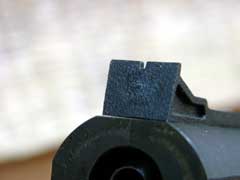
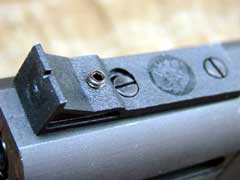
Polymer rear sight is adjustable for windage and elevation correction, and can be removed to attach a scope mount.
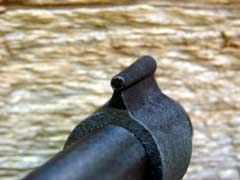
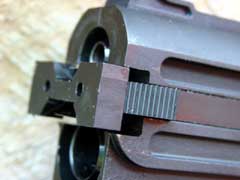
Manual extractor.
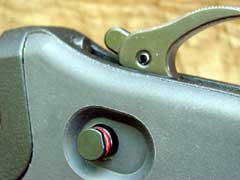
Crossbolt safety blocks hammer from contacting firing pins.
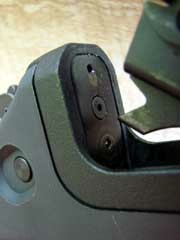
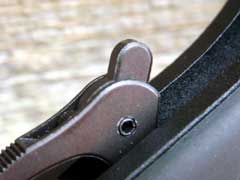

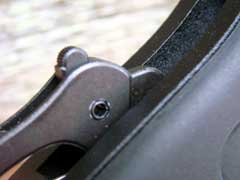
Hammer nose rotates to select upper or lower barrel to fire.
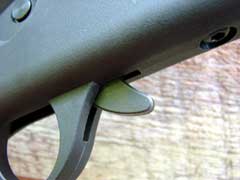
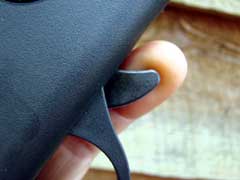
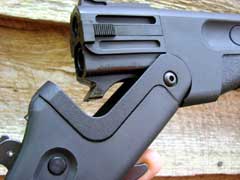
Action release lever.
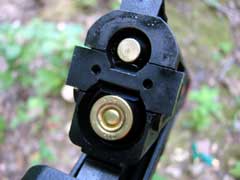
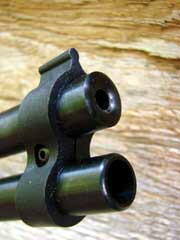
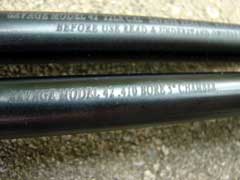
Upper barrel is chambered for the 22 long rifle cartridge. Lower barrel is chambered for 410 bore shotshell.

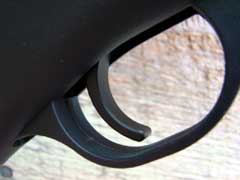
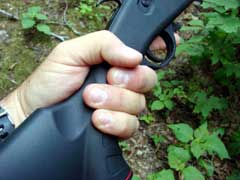
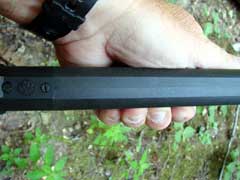
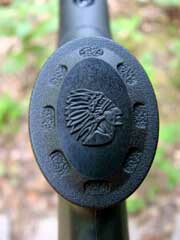
|
|
Savage Arms has a history of producing
good-shooting, affordable combination guns. Unlike many of the
European combo guns that cost more than a new pickup truck, the
Savage Model 24 that was built in the 1950s, 60s, and 70s
provided shooters, campers, hunters, and survivalists with handy
firearms that would fire both rifle and shotgun ammunition, at
prices that most folks could afford. However, several variations
of these discontinued Model 24 combination guns are now fetching
princely sums of money, as most folks who have these guns are
not willing to part with them. If you do find one for sale, they
are sometimes in pretty rough condition, as these were working
guns; riding in pickup trucks and living in the woods much of
the time.
Savage has now introduced a thoroughly
modernized version of the Model 24, called the Model 42. Instead
of blued steel and walnut, the Model 42 wears a matte black
finish on the receiver and a satin black finish on the barrels,
all fitted into a lightweight black polymer stock. The forend is
slim and easy to grasp, with long finger-grooves on each side,
and texturing along the bottom. It is very comfortable to hold.
The buttstock has a generous pistol grip, also textured for a
secure hold. The polymer is impervious to harsh weather and
rough handling. The recoil pad is soft and effective, and the
black stock is accented with red butt pad, pistol grip cap, and
forend cap spacers. “Savage Arms” is proudly shown in red
letters along each side of the forend. The action is a
non-ferrous casting, with the barrels, mono-block, trigger,
hammer, and other small parts made of steel. Thankfully, the
Model 42 has sling studs, as should any such firearm that is
meant to live in the great outdoors. The barrels measure twenty
inches in length. Each barrel measures .555 inch diameter. As
far as I can tell, the 410 barrel has no choke constriction, and
it is not threaded to accept choke tubes.
To open the action of the Model 42 for
loading, a lever in front of the trigger guard is pulled
rearward by the shooter’s trigger finger. The mono-block
hinges to allow loading and unloading of the weapon. The upper
barrel accepts any 22 Long Rifle cartridge (a 22 Magnum version
will be available later), and the bottom barrel accepts any 2.5
or 3 inch 410 shotshell. The crossbolt safety pushes to the left
to fire. The rebounding hammer is blocked from contacting the
firing pins unless the trigger is pulled. The hammer nose
rotates to select either the upper or lower barrel to fire. The
extractor is manually operated, but I found it easier to just
flick out the empty 22 cartridges with my fingernail, using the
extractor to remove the empty 410 hulls.
The Model 42 is very light and handy,
weighing in at just under four and three-quarters pounds (4
lbs., 10.6 ounces, to be precise) on my scale. The overall
length measures thirty-five and three-quarters inches, and the
length of pull measures thirteen and one-half inches. The
trigger pull feels somewhat heavy, but released crisply with
five and one-half pounds of resistance, as measured on my Lyman
digital scale.
I tested the Model 42 combo gun to check for
velocities from the twenty-inch rifle barrel with several brands
of 22 Long Rifle ammunition. I also shot some of the 000 Federal
buck across the chronograph to check for velocity from the 410
barrel. The results with each brand and type of ammunition are
listed in the chart below. HP is a lead hollowpoint bullet.
Solid is a lead roundnose bullet. Velocity readings were taken
at an elevation of 541 feet above sea level, with an air
temperature of eighty-nine degrees Fahrenheit, and humidity in
the fifty-one percent range. Velocities are listed in
feet-per-second (FPS), and were recorded ten feet from the
muzzle of the rifle and shotgun barrels. Bullet weights are
listed in grains.
| Ammunition |
Bullet Weight |
Velocity |
| Federal Bulk HP |
36 |
1266 |
| Winchester DynaPoint HP |
40 |
1168 |
| PMC Match Solid |
40 |
1069 |
| Wolf Match Solid |
40 |
1022 |
| CCI Mini-Mag HP |
36 |
1265 |
| CCI Mini-Mag Solid |
40 |
1222 |
| CCI Velocitor HP |
40 |
1397 |
| Remington Yellow Jacket
HP |
33 |
1423 |
| Remington Hi-Speed
Solid |
40 |
1254 |
| American Eagle HP |
36 |
1158 |
| PMC Zapper HP |
38 |
1276 |
| Olin Solid |
40 |
1043 |
| Winchester XPert HP |
36 |
1197 |
| Hansen Solid |
40 |
1121 |
| CCI Blazer Solid |
40 |
1224 |
| CCI Stinger HP |
32 |
1515 |
| CCI Quiet22 |
40 |
690 |
| |
|
|
| Federal 000 Buckshot |
4x62 |
1090 |
The polymer mechanical sights proved to be
plenty accurate enough to shoot very good groups at twenty-five
yards, even with my aging eyes. The rear sight is removable for
the attachment of a scope mount, but I did not have one
available, so used the Model 42 with the supplied mechanical
sights only. The rear sight is adjustable for both windage and
elevation correction. The shotgun barrel patterned very well
using buckshot, birdshot, and the Winchester PDX1 ammunition.
The three-inch chamber will accommodate any 2.5 or three inch
410 shotshell.
Many shooters frown at the perceived power of
the 410, and doubt its effectiveness. The 410 pellets hit the
target just as hard as do the pellets thrown from a larger gauge
shotgun; they just do not have as many pellets in the pattern.
Birds and small game are killed with just a few pellets, so the
410 is plenty capable of taking small game out to twenty yards
or so with the 410 barrel of this Model 42. Beyond that, the
pattern gets pretty sparse, so the hunter should select the
upper 22 Long Rifle barrel at greater distances.
The Model 42 functioned perfectly, with one
exception. Early on in the shooting, the hammer spring strut
slipped out of engagement with the hammer. I removed the
buttstock and put it back into place, and no further problems
were encountered. Maybe the hammer strut was not fully engaged
with its notch before leaving the factory; I don’t know.
Anyway, that was the only problem noted, and the Model 42
continued to function one hundred percent after that incident.
The Savage Model 42 would make a dandy trail
gun, truck gun, survival gun, or companion around the camp. The
22 Long Rifle cartridge is very efficient, and useful for
collecting critters for the camp pot, and the 410 barrel
patterns well enough for bird hunting at close range. The 410 is
also very useful for dispatching venomous snakes around camp, or
around the home. The 410 is also an effective defensive weapon
against predators of the human type, using buckshot or the PDX1
defensive ammunition.
The Model 42 is a modernized version of an
old classic. It is lighter, shorter, and handier than its
predecessor. While the new Model 42 might not be as visually
appealing to traditional shooters, the old Model 24 was not
exactly a handsome gun. The beauty of the new Model 42 lies in
its versatility, handiness, and function. It is like the
multi-tool of the firearms world, providing shooters a variety
of ammunition choices in one handy package.
Check out the extensive line of Savage
firearms and accessories at www.savagearms.com.
For the location of a Savage dealer near you,
click on the DEALER FINDER at www.lipseys.com.
To order the Model 42 online, go to www.galleryofguns.com.
To order 22
Long Rifle and 410
shotshell ammunition online, go to www.luckygunner.com.
Jeff Quinn
  
Got something to say about this article?
Want to agree (or disagree) with it? Click the following link to
go to the GUNBlast Feedback Page.
|
|
Click pictures for a larger version.

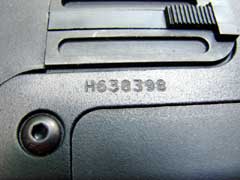


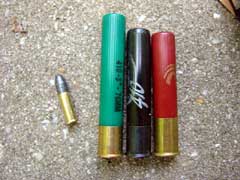


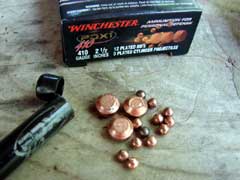
The Model 42 will fire a variety of 410 2.5 or 3 inch shotshells.
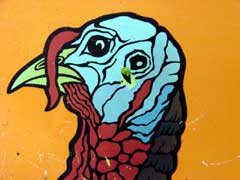
The Model 42 is plenty accurate enough for a headshot at 25 yards, using the mechanical sights.

410 holds a tight pattern at ten feet from the muzzle.
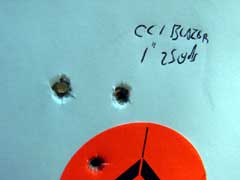
One- inch groups were the limit of the author's ability at 25 yards using the mechanical sights.
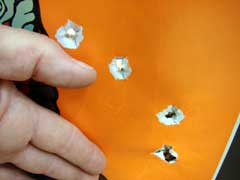
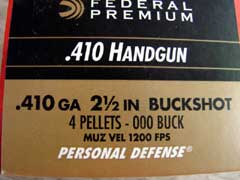
Federal four-ball 000 buckshot patterned well at 25 yards, and would be an effective defensive load.
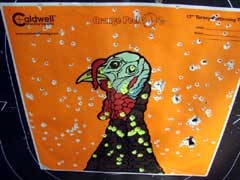
Pattern of number 7 1/2 birdshot at 50 feet.
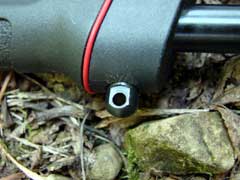

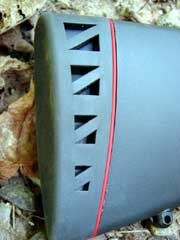

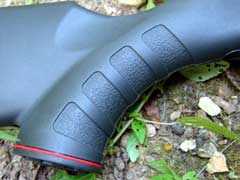
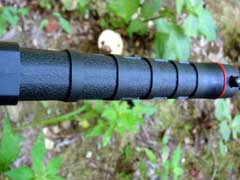

|
![]()